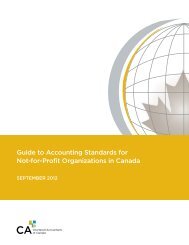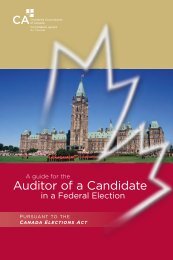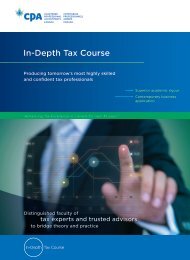20 Questions - Canadian Institute of Chartered Accountants
20 Questions - Canadian Institute of Chartered Accountants
20 Questions - Canadian Institute of Chartered Accountants
You also want an ePaper? Increase the reach of your titles
YUMPU automatically turns print PDFs into web optimized ePapers that Google loves.
Strategic PlanningStrategic planning can be described as determining where the organization isnow, where it would like to be in the future, and how it intends to get there.Most not-for-pr<strong>of</strong>it organizations start <strong>of</strong>f with a fairly clear idea <strong>of</strong> what theywant to accomplish and what they stand for. The founding members spendtime talking about these things and, if they incorporate, they write them downas the purpose <strong>of</strong> the organization.Over time, the original passion and energy can get diluted by practicalitiesand problems, circumstances and needs may change and the organization riskslosing its sense <strong>of</strong> purpose, relevance and commitment. Strategic planning is away to invigorate and strengthen an organization by establishing longer rangeobjectives and focusing on the important - not just the urgent. The results <strong>of</strong>planning provide information for members and funding sources.Strategic planning also provides guidance to staff and volunteers for developingwork plans, projects and budgets and for the effective management <strong>of</strong> resources.A strategic plan describes how an organization intends to move from where it isnow towards its vision in accordance with its mission, values and tolerance forrisk. In so doing it plans to use its strengths to take advantage <strong>of</strong> opportunities,remedy its weaknesses and to avoid or mitigate threats. The plan alsoestablishes how the organization will measure progress in meeting its objectives.This section explores these concepts and concludes with discussions <strong>of</strong> theresponsibilities for planning and <strong>of</strong> how the planning elements described abovecan fit into a planning process. (<strong>Questions</strong> 11 and 12)Appendix 2 is an example <strong>of</strong> how all the elements in the planning process canfit together.1. What is the organization’s vision?There are no formal rules for visions – what organizations want to accomplish.Organizations adopt visions that work for them and inspire their members, staffand supporters. For example: vision statements may describe:• how things would be different as a result <strong>of</strong> the organization’s activities• how the organization wants to be seen by othersGood visions are aspirational. Some are hard-to-reach ideals as in MartinLuther King’s memorable words “I have a dream…”. Others are more modestor describe objectives that are achievable in the present or near future. In eithercase, the vision helps establish the unique contribution that the organizationmakes to society (the “value proposition” in business language) and providesjustification for support from its community, members, donors, sponsors andgovernment.From a practical perspective a vision can be a quick, memorable way to describethe organization’s reason for being. This can be valuable in times <strong>of</strong> difficultyor crisis when it helps to remember what is really important. For these andother reasons, the vision is <strong>of</strong>ten published in the organization’s annual reports,brochures and fund-raising materials.Recommended practices• The vision clearly explains what the organization aspires to accomplish• The board approves the vision• The vision is communicated to staff, volunteers, members and otherstakeholdersVisions“Creating a world where no <strong>Canadian</strong> fears cancer.”<strong>Canadian</strong> Cancer Society“Queen’s University will be recognized as an innovative, inclusiveand rigorous community <strong>of</strong> learning and discovery that is committedto serving as a national resource for the betterment <strong>of</strong> our globalsociety.”Queen’s UniversityVision and MissionActive Healthy Kids CanadaOur Vision: A nation <strong>of</strong> active, healthy kids.Our Mission: Active Healthy Kids Canada is committed to inspiringthe nation to engage all children and youth in physical activity.5

















